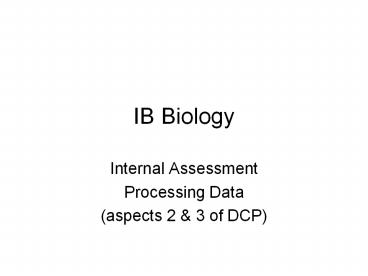IB Biology
Title: IB Biology
1
IB Biology
- Internal Assessment
- Processing Data
- (aspects 2 3 of DCP)
2
Processing raw data presenting processed data
- To help show the trends in data Biologists
usually have to use statistics draw graphs. - This is because of the variability of the
material used as well as variation due to its
manipulation. - A student could show this by calculating a
margin of error. - The simplest would be plus or minus the range of
measurements or plus or minus half the range of
measurements. - If the data permits, the error margin could be
represented by plus or minus the standard
deviation of the mean or the standard error of
the mean. - These ranges may be expressed as error bars on
graphs. Though this is not obligatory
3
The three written parts of Processing
- If you calculate something from the data
- (eg averages, standard deviation, rate of
reaction) - Write a paragraph explaining why you are doing
this calculation - Explain how you did the calculation
- Give details of ONE example
4
Showing Trends (2)
- Do a scatter graph or a bar graph of your
processed data - show errors and use statistics (for e.g.)
- the range of data, or
- standard deviation
- R2 value
- Trend line
- using error bars or trend line. NOT BOTH.
5
Here the student would get complete for
aspects 2 3 of DCP.
- The relationship between the variables is plotted
as a scatter plot and a trend line has been
drawn. - Excel has also been used to calculate a
correlation coefficient R2, which should be used
in the conclusion. (The student should use R2 to
comment just that it is high or low correlation.
)For aspect 3 the correct conventions are used
for the graph. - It has a clear title and
- uncertainties are shown through both the use of
the trend line and the degree of precision on the
x-axis.
The student will have also explained, why how
they did these things in their writing.
6
- The graph is used to process the data by using
the intercepts of the x-axis to establish the
sucrose solutions isotonic to the tissue sap. So
long as this graph is accompanied by a table
showing how the data was processed, aspect 2
would achieve complete. - Note in this method that the calculation of the
percentage change in length is not necessary as
all the pieces of tissue were cut to the same
initial lengths (4.0 cm). - The graph is drawn using the correct conventions,
it has a clear title and uncertainties are given
by the use of trend lines. The axes have
graduations on them to improve the precision of
the estimate of the isotonic solutions. Aspect 3
has achieved complete.
7
Beware! you have to finish the analysis Check
the Aim of your Experiment every time.
- Most of the processing has been done (calculating
the average change in lengths), - Unfortunately the comparison of apple potato is
not complete without the estimation of the
isotonic solutions (where there is no change in
length). - This can only be awarded partial for aspect 2
PROCESSING. - The Potato and the apple were not compared
which was the aim of the experiment.
8
Include Errors in your processing as well as in
the raw data
- The graph is drawn using correct conventions and
the title is appropriate, - but there are no uncertainties given
- as degrees of precision (/-),
- as error bars or
- as a trend line.
- Therefore only partial can be awarded for
aspect 3 of data collection and processing.
9
Conclusions
- Say what the results show, without trying to
explain them - Refer to specific data from the graph or results
table give examples of readings - Say what the text book theory is
- Compare your results to the text book to
justify your conclusion.
10
Limitations
- Range of data
- Number of repeats
- Choice of equipment
- Effectiveness of the method
- Accuracy of the data
11
Improvements
- Must be
- Linked to the limitations
- Specific not general points
- Can describe human error which was unavoidable.
- Must not
- Say that you did the experiment badly































